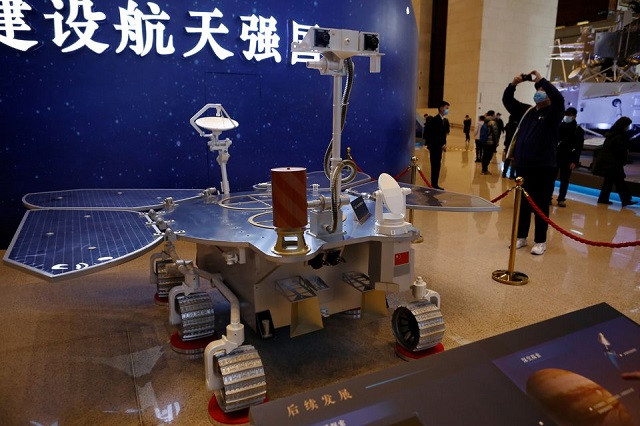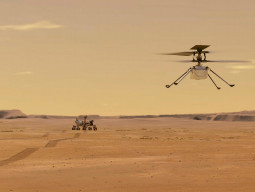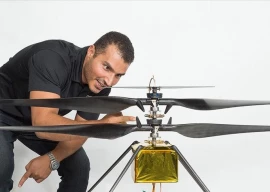
An uncrewed Chinese spacecraft successfully landed on the surface of Mars on Saturday, state news agency Xinhua reported, making China the second space-faring nation after the United States to land on the Red Planet.
The Tianwen-1 spacecraft landed on a site on a vast plain known as Utopia Planitia, "leaving a Chinese footprint on Mars for the first time," Xinhua said.
The lander carrying China's first Mars rover #Zhurong has touched down on the Red Planet, the China National Space Administration confirmed on Saturday morning. Zhurong has been designed to operate in the Red Planet for at least 90 Martian days.
— CGTN (@CGTNOfficial) May 15, 2021
more: https://t.co/avaUv4mvgI pic.twitter.com/cQzQG6U96B
Chinese President Xi Jinping issued a message of congratulations to all the people involved in the mission.
"You were brave enough for the challenge, pursued excellence and placed our country in the advanced ranks of planetary exploration," he said. "Your outstanding achievement will forever be etched in the memories of the motherland and the people."
President #XiJinping on Saturday congratulated the mission team on the landing of China's probe #Tianwen1 on Mars. pic.twitter.com/xIZaLUQx8j
— CGTN (@CGTNOfficial) May 15, 2021
Read: After UAE, Chinese spacecraft successfully enters Mars orbit
The craft left its parked orbit at about 1700 GMT Friday (0100 Beijing time Saturday). The landing module separated from the orbiter three hours later and entered the Martian atmosphere, the official China Space News said.
It said the landing process consisted of "nine minutes of terror" as the module decelerates and then slowly descends.
Hello from #Mars!
— CGTN (@CGTNOfficial) May 15, 2021
China's first Mars rover #Zhurong send out the first Weibo post on Saturday greeting to the public after it touched down on the Red Planet, says it will collect and send back information about the Martian surface in the next few days. pic.twitter.com/bBqmFuQ5hr
The official landing time was 2318 GMT (0718 Beijing time), Xinhua said, citing the China National Space Administration. The rover took more than 17 minutes to unfold its solar panels and antenna and send signals to ground controllers more than 320 million kilometres away.
The rover, named Zhurong, will now survey the landing site before departing from its platform to conduct inspections. Named after a mythical Chinese god of fire, Zhurong has six scientific instruments including a high-resolution topography camera.
Named after the Chinese god of fire, #Zhurong the rover will carry out imaging of the landing site, self-check and depart from the landing platform for further expedition. https://t.co/xFBegw4Ipg pic.twitter.com/OFn09JAblt
— CGTN (@CGTNOfficial) May 15, 2021
It will study the planet's surface soil and atmosphere. Zhurong will also look for signs of ancient life, including any sub-surface water and ice, using a ground-penetrating radar.

A replica of the Tianwen-1 Mars rover is displayed during an exhibition inside the National Museum in Beijing, China March 3, 2021. PHOTO: REUTERS
Tianwen-1, or "Questions to Heaven", after a Chinese poem written two millennia ago, is China's first independent mission to Mars. A probe co-launched with Russia in 2011 failed to leave the Earth's orbit.
The five-tonne spacecraft blasted off from the southern Chinese island of Hainan in July last year, launched by the powerful Long March 5 rocket.
Tech Breakdown: Mars vs. the moon, which is more difficult to land on? https://t.co/ijuI3PnNn5 pic.twitter.com/ufcaqi4w5e
— CGTN (@CGTNOfficial) May 15, 2021
After more than six months in transit, Tianwen-1 reached the Red Planet in February where it had been in orbit since.
If Zhurong is successfully deployed, China would be the first country to orbit, land and release a rover in its maiden mission to Mars.
Tianwen-1 was one of three that reached Mars in February, with US rover Perseverance successfully touching down on Feb. 18 in a huge depression called Jezero Crater, more than 2,000 km away from Utopia Planitia.
Read more: Perseverance rover captures sound of Ingenuity flying on Mars
Hope - the third spacecraft that arrived at Mars in February this year - is not designed to make a landing. Launched by the United Arab Emirates, it is currently orbiting above Mars gathering data on its weather and atmosphere.
The first successful landing ever was made by NASA's Viking 1 in July 1976 and then by Viking 2 in September that year. A Mars probe launched by the former Soviet Union landed in December 1971, but communication was lost seconds after landing.
The landing of China's spacecraft on the surface of Mars is "a great success" of China's fundamental space research program, said Dmitry Rogozin, head of Russia's state space corporation Roscosmos, on Saturday.https://t.co/saoicfkMyO
— CGTN (@CGTNOfficial) May 15, 2021
China is pursuing an ambitious space programme. It is testing reusable spacecraft and is also planning to establish manned lunar research station.
In a commentary published on Saturday, Xinhua said China was “not looking to compete for leadership in space” but was committed to “unveiling the secrets of the universe and contributing to humanity’s peaceful use of space.”
President Xi Jinping on Saturday extended congratulations to China's space mission team on the successful landing of the country's first probe on Mars.https://t.co/pGgpBoVbxd pic.twitter.com/Ggmehf6jXg
— CGTN America (@cgtnamerica) May 15, 2021


























COMMENTS
Comments are moderated and generally will be posted if they are on-topic and not abusive.
For more information, please see our Comments FAQ